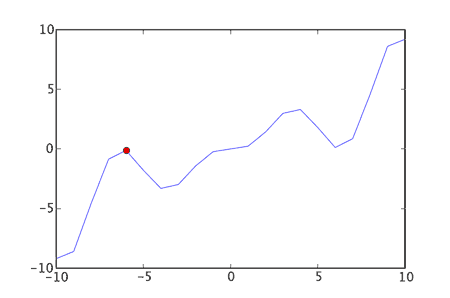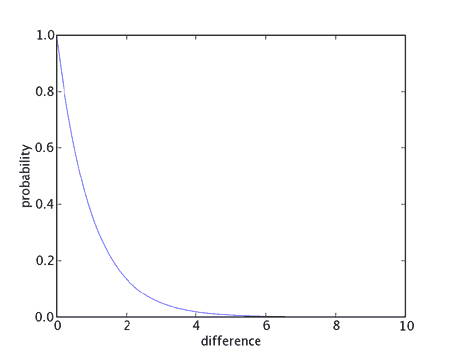This is the third part in my series on the "travelling salesman problem" (TSP). Part one covered defining the TSP and utility code that will be used for the various optimisation algorithms I shall discuss. Part two covered "hill-climbing" (the simplest stochastic optimisation method).
getting stuck, because you're greedy

simulated annealing
Taking it's name from a metallurgic process, simulated annealing is essentially hill-climbing, but with the ability to go downhill (sometimes).
It introduces a "temperature" variable. When the "temperature" is high a worse solution will have a higher chance of being chosen. It work's like this:
- pick an initial solution
- set an initial temperature
- choose the next neighbour of the current solution:
- if the neighbour is "better" make that neighbour the current solution
- if the neighbour is "worse", probabilistically make this neighbour the current solution, based on the current temperature and how much "worse" the neighbour is
- decrease the temperature slightly
- go to 3.
By slowly cooling the temperature we become less likely to choose worse solutions over time. Initially we are able to make some pretty big jumps around the solution landscape. By the end of a run we'll be jumping around less and less. In fact if we lower the temperature enough we end up with plain old hill-climbing.
probabilistically choosing a neighbour
Below is the Python code to decide if what probability we will assign to moving from a solution with a score of prev_score to a solution with a value of next_score at the current temperature.
def P(prev_score,next_score,temperature):
if next_score > prev_score:
return 1.0
else:
return math.exp( -abs(next_score-prev_score)/temperature )
To keep later logic simpler I'm returning 1.0 if next_score is better - so we'll always choose better solutions.

The net-effect being that solutions that are only a little bit worse are still fairly likely to be chosen. Much worse solutions may still be chosen, but it's much less likely.
the cooling schedule
Temperature is a key part of simulated annealing. How we lower the temperature over time is therefore very important. There are a couple of possible approaches, but I'll show the one outlined by Kirkpatrick et al:
def kirkpatrick_cooling(start_temp,alpha):
T=start_temp
while True:
yield T
T=alpha*T
This is a generator function that takes an initial start temperature (start_temp) and returns a series of temperatures that are alpha times the size, where alpha is less than one. So we end up with a temperature that drops off quite quickly and then slowly decreases to practically nothing.
remembering the best solution
One other minor, but key, implementation detail is saving the best solution we find during the annealing process.
During hill-climbing the current solution was always the best solution found, but simulated annealing will deliberately accept worse solutions at times. So we need to make sure we don't just throw away the best we see. To avoid complicating the algorithm itself with extra checks of scores etc.
I am going to use a class to wrap the objective function. I'll override the __call__ method of the class, so that I can use the instance of the class like a function - in place of the normal objective function:
class ObjectiveFunction:
'''class to wrap an objective function and
keep track of the best solution evaluated'''
def __init__(self,objective_function):
self.objective_function=objective_function
self.best=None
self.best_score=None
def __call__(self,solution):
score=self.objective_function(solution)
if self.best is None or score > self.best_score:
self.best_score=score
self.best=solution
return score
We can then access then best and best_score fields when we have finished our annealing.
simulated annealing itself
The code below represents the simulated annealing algorithm. In many respects it is pretty similar to hill-climbing, but we are also concerned with a current temperature and we have introduced a probabilistic element to choosing the next solution.
def anneal(init_function,move_operator,objective_function,max_evaluations,start_temp,alpha):
# wrap the objective function (so we record the best)
objective_function=ObjectiveFunction(objective_function)
current=init_function()
current_score=objective_function(current)
num_evaluations=1
cooling_schedule=kirkpatrick_cooling(start_temp,alpha)
for temperature in cooling_schedule:
done = False
# examine moves around our current position
for next in move_operator(current):
if num_evaluations >= max_evaluations:
done=True
break
next_score=objective_function(next)
num_evaluations+=1
# probablistically accept this solution
# always accepting better solutions
p=P(current_score,next_score,temperature)
if random.random() < p:
current=next
current_score=next_score
break
# see if completely finished
if done: break
best_score=objective_function.best_score
best=objective_function.best
return (num_evaluations,best_score,best)
The parameters are much the same as hill-climbing, but there are two extra specific to simulated annealing:
- init_function - the function used to create our initial solution
- move_operator - the function we use to iterate over all possible "moves" for a given solution
- objective_function - used to assign a numerical score to a solution - how "good" the solution is
- max_evaluations - used to limit how much search we will perform (how many times we'll call the objective_function)
- start_temp - the initial starting temperature for annealing
- alpha - should be less than one. controls how quickly the temperature reduces
I am also only reducing the temperature after either accepting a new solution or evaluating all neighbours without choosing any of them. This is done so that temperature will only decrease as we start accepting moves. As that will be less frequent than just evaluating moves we cooling will happen at a slower pace. If we are accepting lots of moves then this will drop the temperature quite quickly. If we are not accepting many moves the temperature will stay steadier - maintaining the likelihood of accepting other "worse" moves. That latter point is useful, as if we are starting to get stuck on a local maximum the temperature won't decrease - hopefully helping us get unstuck.
results
It made sense to compare simulated annealing with hill-climbing, to see whether simulated annealing really helps us to stop getting stuck on local maximums.
I performed 100 runs of each algorithm on my randomly generated 100 city tour, once with 50000 and once with 100000 evaluations. Both algorithms used the reversed_sections move operator. For simulated annealing I chose an initial temperature and alpha that seemed to perform well.
| evaluations | algorithm | average | s.d. | worst | best |
|---|---|---|---|---|---|
| 50000 | hill-climbing | -4228.50 | 126.45 | -4627.07 | -3942.03 |
| 50000 | annealing (start_temp=10, alpha=0.9999) | -4145.69 | 96.56 | -4422.04 | -3924.34 |
| 100000 | hill-climbing | -4154.25 | 90.60 | -4513.11 | -3946.65 |
| 100000 | annealing (start_temp=10, alpha=0.99995) | -4077.40 | 71.72 | -4294.97 | -3907.19 |
These results seem to show that simulated annealing performed better than hill-climbing. In fact it can be seen that with just 50000 evaluations, simulated annealing was able to do a slightly better job than hill-climbing with 100000 evaluations! This makes sense, as when running hill-climbing with logging turned on I could see that after about 50000 evaluations hill-climbing was getting stuck and restarting. With more evaluations available it was possible to push simulated annealing further still.
However in both cases I had to perform several test runs to find reasonable starting temperatures and alpha values to get these kind of results. It was quite easy to set these parameters wrong and get much worse results than with hill-climbing.
conclusion
Simulated annealing is a pretty reasonable improvement over hill-climbing. For a modest amount of extra code (in this cases 10's of lines) we are able to address hill-climbing's fundamental weakness (getting stuck) and yield much better results.
However by introducing two extra parameters we have shifted some of the burden in finding good solutions to ourselves. We have to tune these parameters carefully. Values that are good for one problem may not work so well for another. We end up with more "switches to flick" in the hope of making something work.
Next time around I will be discussing evolutionary algorithms, which pursue other ways to avoid getting stuck on local maximums and are also able to combine several solutions to explore new areas of the solution landscape.
source-code
Full source-code is available here as a .tar.gz file.
(The source-code contains more code than shown here, to handle parsing parameters passed to the program etc. I’ve not discussed this extra code here simply to save space.)